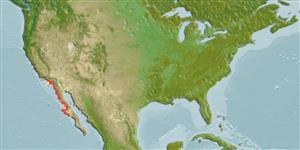Common names from other countries
Environment: milieu / climate zone / depth range / distribution range
Ecología
marino demersal; rango de profundidad 1 - 22 m (Ref. 96339). Subtropical; 42°N - 22°N, 125°W - 106°W
Eastern Pacific: Point Conception in California, USA to southern Baja California, Mexico.
Tamaño / Peso / Age
Maturity: Lm ? range ? - ? cm
Max length : 70.0 cm TL macho / no sexado; (Ref. 9118); common length : 30.0 cm TL macho / no sexado; (Ref. 9118); peso máximo publicado: 4.8 kg (Ref. 2850); edad máxima reportada: 15 años (Ref. 56049)
Occur in sandy shores and bays, mostly in shallow surf zones, but also to 15 m depth. Often found near rocks and entrances to bays. Usually form small groups, but aggregate for spawning. Pelagic spawners (Ref. 56049). Feed on invertebrates, such as marine worms, clams, crabs and small crustaceans.
Life cycle and mating behavior
Madurez | Reproducción | Puesta | Huevos | Fecundidad | Larva
Pelagic spawner (Ref. 56049).
Eschmeyer, W.N., E.S. Herald and H. Hammann, 1983. A field guide to Pacific coast fishes of North America. Boston (MA, USA): Houghton Mifflin Company. xii+336 p. (Ref. 2850)
IUCN Red List Status (Ref. 130435)
CITES (Ref. 128078)
Not Evaluated
Threat to humans
Harmless
Human uses
Pesca deportiva: si
Más información
ReferenciasAcuiculturaPerfil de acuiculturaRazasGenéticaElectrophoresesheritabilidadEnfermedadesProcesamientoMass conversion
ColaboradoresImágenesStamps, Coins Misc.SonidosCiguateraVelocidadTipo de nataciónSuperficie branquialOtolitosCerebrosVisión
Herramientas
Special reports
Download XML
Fuentes de Internet
Estimates based on models
Preferred temperature (Ref.
115969): 15.9 - 19.5, mean 17.8 (based on 20 cells).
Phylogenetic diversity index (Ref.
82804): PD
50 = 1.0000 [Uniqueness, from 0.5 = low to 2.0 = high].
Bayesian length-weight: a=0.00851 (0.00413 - 0.01752), b=3.08 (2.91 - 3.25), in cm Total Length, based on LWR estimates for this (Sub)family-body shape (Ref.
93245).
Nivel trófico (Ref.
69278): 3.3 ±0.44 se; based on food items.
Resiliencia (Ref.
120179): Medio, población duplicada en un tiempo mínimo de 1.4-4.4 años (tm=2.5; tmax=15).
Fishing Vulnerability (Ref.
59153): Moderate vulnerability (39 of 100).
